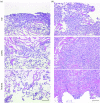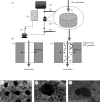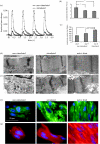Biomimetic approach to cardiac tissue engineering
- PMID: 17594967
- PMCID: PMC2440401
- DOI: 10.1098/rstb.2007.2121
Biomimetic approach to cardiac tissue engineering
Abstract
Here, we review an approach to tissue engineering of functional myocardium that is biomimetic in nature, as it involves the use of culture systems designed to recapitulate some aspects of the actual in vivo environment. To mimic the capillary network, subpopulations of neonatal rat heart cells were cultured on a highly porous elastomer scaffold with a parallel array of channels perfused with culture medium. To mimic oxygen supply by haemoglobin, the culture medium was supplemented with a perfluorocarbon (PFC) emulsion. Constructs cultivated in the presence of PFC contained higher amounts of DNA and cardiac markers and had significantly better contractile properties than control constructs cultured without PFC. To induce synchronous contractions of cultured constructs, electrical signals mimicking those in native heart were applied. Over only 8 days of cultivation, electrical stimulation induced cell alignment and coupling, markedly increased the amplitude of synchronous construct contractions and resulted in a remarkable level of ultrastructural organization. The biomimetic approach is discussed in the overall context of cardiac tissue engineering, and the possibility to engineer functional human cardiac grafts based on human stem cells.
Figures






Similar articles
-
Biophysical regulation during cardiac development and application to tissue engineering.Int J Dev Biol. 2006;50(2-3):233-43. doi: 10.1387/ijdb.052041sg. Int J Dev Biol. 2006. PMID: 16479491 Review.
-
Biomimetic approach to cardiac tissue engineering: oxygen carriers and channeled scaffolds.Tissue Eng. 2006 Aug;12(8):2077-91. doi: 10.1089/ten.2006.12.2077. Tissue Eng. 2006. PMID: 16968150
-
Functional assembly of engineered myocardium by electrical stimulation of cardiac myocytes cultured on scaffolds.Proc Natl Acad Sci U S A. 2004 Dec 28;101(52):18129-34. doi: 10.1073/pnas.0407817101. Epub 2004 Dec 16. Proc Natl Acad Sci U S A. 2004. PMID: 15604141 Free PMC article.
-
Synthetic oxygen carriers in cardiac tissue engineering.Artif Cells Blood Substit Immobil Biotechnol. 2007;35(1):135-48. doi: 10.1080/10731190600974988. Artif Cells Blood Substit Immobil Biotechnol. 2007. PMID: 17364478 Review.
-
Electric field stimulation integrated into perfusion bioreactor for cardiac tissue engineering.Tissue Eng Part C Methods. 2010 Dec;16(6):1417-26. doi: 10.1089/ten.TEC.2010.0068. Epub 2010 May 10. Tissue Eng Part C Methods. 2010. PMID: 20367291
Cited by
-
Addition of perfluorocarbons to alginate hydrogels significantly impacts molecular transport and fracture stress.J Biomed Mater Res A. 2013 Feb;101(2):438-46. doi: 10.1002/jbm.a.34344. Epub 2012 Aug 3. J Biomed Mater Res A. 2013. PMID: 22865503 Free PMC article.
-
Introduction. Bioengineering the heart.Philos Trans R Soc Lond B Biol Sci. 2007 Aug 29;362(1484):1253-5. doi: 10.1098/rstb.2007.2112. Philos Trans R Soc Lond B Biol Sci. 2007. PMID: 17569644 Free PMC article. No abstract available.
-
Cardiomyocytes in vitro adhesion is actively influenced by biomimetic synthetic peptides for cardiac tissue engineering.Tissue Eng Part A. 2012 Apr;18(7-8):725-36. doi: 10.1089/ten.TEA.2011.0254. Epub 2011 Dec 5. Tissue Eng Part A. 2012. PMID: 22011064 Free PMC article.
-
Hybrid PGS-PCL microfibrous scaffolds with improved mechanical and biological properties.J Tissue Eng Regen Med. 2011 Apr;5(4):283-91. doi: 10.1002/term.313. J Tissue Eng Regen Med. 2011. PMID: 20669260 Free PMC article.
-
Drug releasing systems in cardiovascular tissue engineering.J Cell Mol Med. 2009 Mar;13(3):422-39. doi: 10.1111/j.1582-4934.2008.00532.x. J Cell Mol Med. 2009. PMID: 19379142 Free PMC article. Review.
References
-
- Akins R.E, Boyce R.A, Madonna M.L, Schroedl N.A, Gonda S.R, McLaughlin T.A, Hartzell C.R. Cardiac organogenesis in vitro: reestablishment of three-dimensional tissue architecture by dissociated neonatal rat ventricular cells. Tissue Eng. 1999;5:103–118. doi:10.1089/ten.1999.5.103 - DOI - PubMed
-
- Balsam L.B, Wagers A.J, Christensen J.L, Kofidis T, Weissman I.L, Robbins R.C. Haematopoietic stem cells adopt mature haematopoietic fates in ischaemic myocardium. Nature. 2004;428:668–673. doi:10.1038/nature02460 - DOI - PubMed
-
- Beltrami A.P, et al. Adult cardiac stem cells are multipotent and support myocardial regeneration. Cell. 2003;114:763–776. doi:10.1016/S0092-8674(03)00687-1 - DOI - PubMed
-
- Brilla C.G, Maisch B, Rupp H, Sunck R, Zhou G, Weber K.T. Pharmacological modulation of cardiac fibroblast function. Herz. 1995;20:127–135. - PubMed
-
- Burlew B.S, Weber K.T. Cardiac fibrosis as a cause of diastolic dysfunction. Herz. 2002;27:92–98. doi:10.1007/s00059-002-2354-y - DOI - PubMed
Publication types
MeSH terms
Substances
Grants and funding
LinkOut - more resources
Full Text Sources
Other Literature Sources
Miscellaneous

